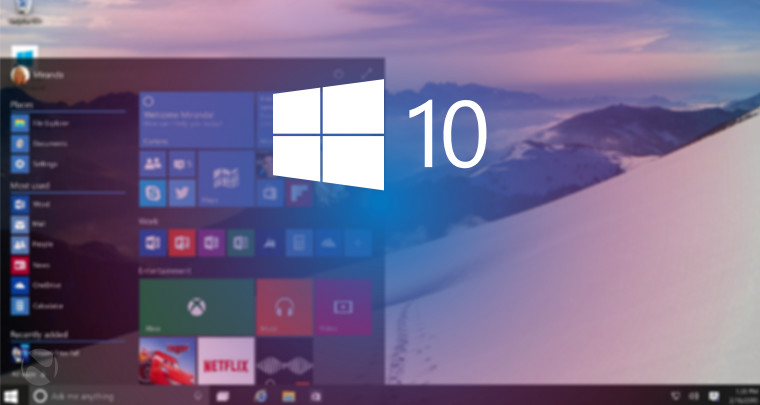
Microsoft has recently announced the official date when Windows 10 will be available, and you can find out more about how to take advantage of the free upgrade from Windows 7 and 8.x offer here. The company has also offered details about what hardware is needed to run this release, and it's worth noting that the requirements are pretty much the same as those for Windows 7 and Windows Vista, which was launched in 2007:
- Processor: 1 gigahertz (GHz) or faster processor or SoC
- RAM: 1 gigabyte (GB) for 32-bit or 2 GB for 64-bit
- Hard disk space: 16 GB for 32-bit OS 20 GB for 64-bit OS
- Graphics card: DirectX 9 or later with WDDM 1.0 driver
- Display: 1024x600
While the general requirements for running Windows 10 are pretty low, there are additional requirements in order to take advantage of all the new features, and some of them will also be limited to certain regions at first:
- Cortana is only currently available on Windows 10 for the United States, United Kingdom, China, France, Italy, Germany, and Spain.
- Speech recognition will vary by device microphone. For better speech experience you will need a
- High fidelity microphone array
- Hardware driver with Microphone array geometry exposed
- Windows Hello requires specialized illuminated infrared camera for facial recognition or iris detection or a finger print reader which supports the Window Biometric Framework.
- Continuum is available on all Windows 10 editions by manually turning “tablet mode” on and off through the Action Center. Tablets and 2-in-1’s with GPIO indicators or those that have a laptop and slate indicator will be able to be configured to enter “tablet mode” automatically.
- Music and Video stream through the Xbox Music or Xbox video available in certain regions. For the most up to date list of regions, please go to Xbox on Windows website.
- Two factor authentication requires the use of a PIN, Biometric (finger print reader or illuminated infrared camera), or a phone with WiFi or Bluetooth capabilities.
- Device Guard requires:
- UEFI Secure Boot with 3rd party UEFI CA removed from the UEFI database
- TPM 2.0
- Virtualization Support configured on by default in the System Firmware (BIOS)
- Virtualization extensions (e.g. Intel VT-x, AMD RVI)
- Second Level Address Translation (e.g. Intel EPT, AMD RVI)
- IOMMU (e.g. Intel VT-d, AMD-Vi)
- UEFI BIOS configured to prevent unauthorized user from disabling Device Guard hardware security features
- Kernel mode drivers need to be Microsoft signed and compatible with hypervisor enforced code integrity
- Only available on Windows 10 Enterprise
- The number of applications that can be snapped will depend upon the minimum resolution for the application.
- To use touch, you need a tablet or a monitor that supports multi-touch (more info)
- Microsoft account required for some features
- Internet access (ISP fees might apply)
- Secure boot requires firmware that supports UEFI v2.3.1 Errata B and has the Microsoft Windows Certification Authority in the UEFI signature database
- Some IT administrators may enable Secure Logon (Ctrl + Alt + Del) before bringing you to the log in screen. On tablets without a keyboard, a tablet with the Windows button maybe required as the key combination on a tablet is Windows button + Power button.
- Some games and programs might require a graphics card compatible with DirectX 10 or higher for optimal performance
- BitLocker To Go requires a USB flash drive (Windows 10 Pro only)
- BitLocker requires either Trusted Platform Module (TPM) 1.2, TPM 2.0 or a USB flash drive (Windows 10 Pro and Windows 10 Enterprise only)
- Client Hyper-V requires a 64-bit system with second level address translation (SLAT) capabilities and additional 2 GB of RAM (Windows 10 Pro and Windows 10 Enterprise only)
- Miracast requires a display adapter which supports Windows Display Driver Model (WDDM) 1.3, and a Wi-Fi adapter that supports Wi-Fi Direct
- Wi-Fi Direct Printing requires a Wi-Fi adapter that supports Wi-Fi Direct and a device that supports Wi-Fi Direct Printing
- To install a 64-bit OS on a 64-bit PC, your processor needs to support CMPXCHG16b, PrefetchW, and LAHF/SAHF
- InstantGo works only with computers designed for Connected Standby
- Device encryption requires a PC with InstantGo and TPM 2.0.
If you're wondering about how long it will take to install Windows 10, Microsoft recommends that you plan for an hour for the installation, but your mileage may vary. Newer devices should only take about 20 minutes to complete the process, provided that you already pre-loaded the new OS installation files.
It's nice to see that Microsoft has made it very easy for people with older hardware to run Windows 10, and this will likely help the company achieve its goal of getting the new OS on at least 1 billion devices. Looking from a different perspective, the low system requirements will likely not stimulate sales of new PCs, that continue to decline in favor of newer device form factors such as 2-in-1s.
Source: Microsoft

















35 Comments - Add comment